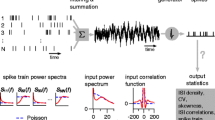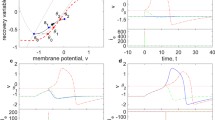Abstract.
Using Stein's model with and without reversal potentials, we investigated the mechanism of production of spike trains with a CV (ISI) (standard deviation/mean interspike interval) greater than 0.5, as observed in the visual cortex. When the attractor of the deterministic part of the dynamics is below the firing threshold, spike generation results primarily from random fluctuations. Using computer simulation for a range of membrane decay times and with other model parameters set to values appropriate for the visual cortex, we demonstrate that CV (ISI) is then usually greater than 0.5; if the attractor is above the threshold, spike generation is mainly due to deterministic forces, and CV (ISI) is then usually lower than 0.5. The critical value of the inhibitory postsynaptic potential (IPSP) rate at which CV (ISI) becomes greater than 0.5 is determined, resulting in specifications of how neurones might adjust their synaptic inputs to elicit irregular spike trains.
Similar content being viewed by others
Author information
Authors and Affiliations
Additional information
Received: 25 June 1998/Accepted in revised form: 16 December 1998
Rights and permissions
About this article
Cite this article
Feng, J., Brown, D. Coefficient of variation of interspike intervals greater than 0.5. How and when?. Biol Cybern 80, 291–297 (1999). https://doi.org/10.1007/s004220050526
Issue Date:
DOI: https://doi.org/10.1007/s004220050526




